![]()
![]()
![]()
Use LEFT and RIGHT arrow keys to navigate between flashcards;
Use UP and DOWN arrow keys to flip the card;
H to show hint;
A reads text to speech;
46 Cards in this Set
- Front
- Back
|
• Describe the location of the ovary, its relationships and neurovascular supply
• Describe the uterine tube and the significance of the opening in its lateral end • Name the parts of the uterus and describe its location, relationships and neurovascular supply • Describe the structures of the vagina, its location, orientation and relationships • Describe the relationship of peritoneum to the internal female genitalia including the peritoneal pouches • Identify and describe the external genitalia • Describe the innervation of the female genital tract and relate this to the pain of childbirth • Compare and contrast the development of male and female genitalia |
Learning Outcomes
|
|
|
Uterine adnexa
|
(structures associated with uterus) – ovaries, uterine tubes
|
|
|
Vulva /pudendum
|
female external genitalia
|
|
|
Introitus
|
external vaginal opening
|
|
|
Birth canal
|
cervix, vagina, vestibule of vagina
|
|
|
Female Reproductive Tract
|
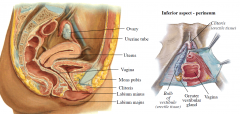
|
|
|
Descent of ovaries
|
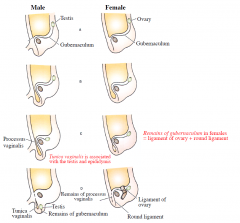
|
|
|
Female Development
|
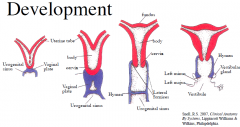
|
|
|
Mullerian vs Wolffian Duct
|
Mullerian duct:
- Degenerates in males - In females, it forms the fallopian tubes, uterus, cervix and upper two thirds of the vagina Wolffian duct: - In the absence of testosterone, it will degenerate in females - In males, it forms the epididymis, the vas deferens and the seminal vesicle |
|
|
Developmental Anomalies
|
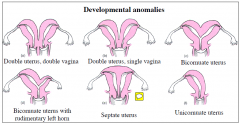
|
|
|
Ovaries Staging
|
- At sexual maturity, primary oocytes
complete fist meiotic division to become secondary oocytes (mediated by FSH) - Secondary follicles look similar to primary follicles, except they are larger & have more follicular cells - Corona radiata is the innermost layer of the ovum and supplies its nutrients. Zona pellucida is a protective layer - Corpus luteum maintains endometrium of the uterus by secreting progesterone |
|
|
Ovarian Cycles
|
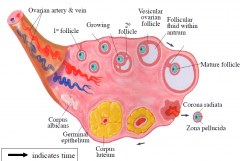
|
|
|
Ovarian Attachments
|
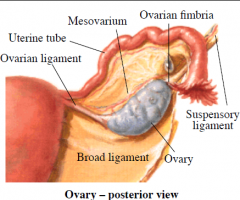
- to back of broad ligament by the mesovarium
- to uterus by ligament of the ovary - to uterine tube by one or more fimbriae |
|
|
Suspensory Ligaments
|
• The suspensory ligament contains the ovarian vessels and attaches the ovaries to the pelvic wall
|
|
|
Uterus
|
Uterus (womb)
- Pear-shaped, thick-walled, hollow muscular organ which is the normal site of implantation - Two parts are the body & cervix - Cervix has a vaginal and supravaginal part - Endocervix is mucous membrane lining cervical canal - Ectocervix is portion of cervix related to vagina (lined by stratified squamous epithelium) - Layers of the uterus: endometrium (cyclical changes); myometrium (smooth muscle); and perimetrium (serosal covering of peritoneum) |
|
|
Uterine tube
|
Uterine tube (Fallopian tube)
- Transports oocytes from ovary to uterus - Infundibular end opens into peritoneal - About 10cm long - Ampulla is longest part, has widest lumen and is normal location of fertilisation. |
|
|
Appearance of external os
|

|
|
|
Uterus and Uterine Tubes
|
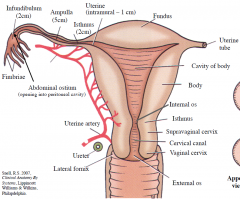
|
|
|
Uterosalpingogram
|
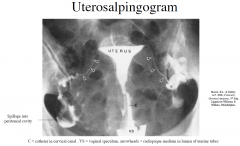
Uterosalpingogram (hysterosalpingogram)
- Radiopaque material is injected into uterus through the external os. - Contrast medium fills triangular-shaped cavity of the body, the lumen of uterine tube, and if the uterine tubes are patent it spills into the peritoneal cavity on each side - Purpose: to check for tubal obstruction as a cause of infertility, to check uterus for fibroids, polyps or developmental abnormalities |
|
|
Uterus Relationships
|
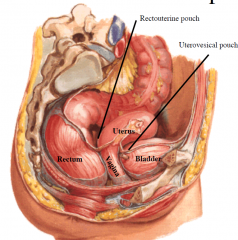
Peritoneal relationships: peritoneum reflects from rectum to posterior fornix and uterus
creating the rectouterine pouch; and reflects from uterus to bladder creating the uterovesical pouch Superior relationships: intestines. Posterior relationships: rectouterine pouch (with loops of intestine) and rectum. Anterior relationships: base of bladder |
|
|
Angles of the uterus
|
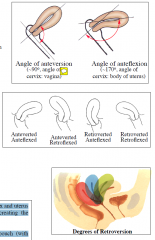
|
|
|
Broad Ligament
|
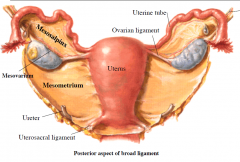
Broad ligament is a double layer of peritoneum lateral to uterus. Extends to pelvic wall, pelvic floor and uterine tube
Parts: mesosalpinx, mesovarium, mesometrium and suspensory ligament Between layers of the broad ligament on each side are the ligament of the ovary & round ligament of uterus |
|
|
Round and Ovarian Ligaments
|
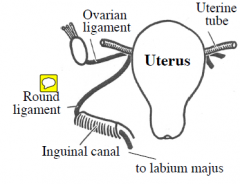
Round ligament & ovarian ligament are the remains of the gubernaculum in the female
They attach to the uterus below the uterine tube. Round ligament passes through inguinal canal to labium majus and steches causing pain during pregancy |
|
|
Support of the Uterus
|
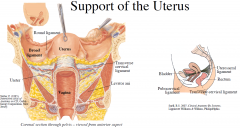
Passive support of the uterus via pubocervical ligament (attaches cervix to pubis), uterosacral ligament (attaches
posterior cervix to sacrum), and transverse cervical ligament (attaches cervix to lateral pelvic wall and sacrum) Active support of the uterus via the pelvic diaphragm in particular levator ani Weaker muscles with age and reduced oestrogen lead to more reliance on these ligaments which stretch over time leading to prolapse of uterus |
|
|
Failure of support leads to prolapse
|
Weak muscles or problems with integrity of perineal body result in the ligaments taking more tension
Kegel exercises to strengthen pelvic floor in females may help prevent prolapse |
|
|
Prolapse
|
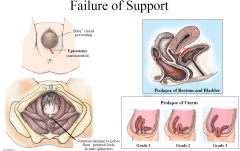
|
|
|
Blood Supply
|
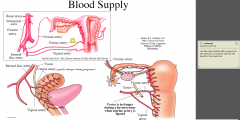
• The uterine and vaginal arteries are branches of the internal iliac artery. The ovarian arteries originate
from the abdominal aorta, inferior to the renal arteries |
|
|
Veins
|
Follows arteries (except erectile tissue, which drains by dorsal vein of clitoris into vesical venous plexus in pelvis)
Right ovarian vein drains to IVC Left ovarian vein drains to left renal vein |
|
|
Uterus Relationships - Pregnancy
|
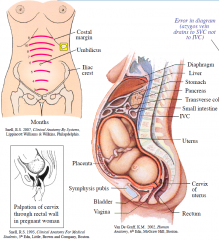
|
|
|
Physiology of Pregnancy
|
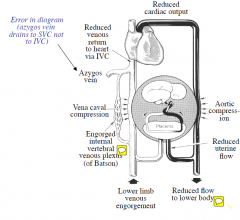
|
|
|
Hysterectomy
|
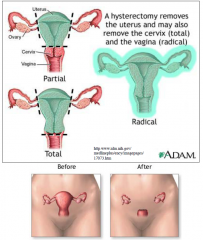
|
|
|
Surgical Approaches to hysterectomy
|
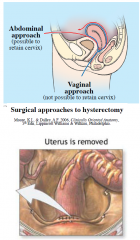
|
|
|
Ampulla
|
• The ampulla is the longest and widest part of the uterine tubes and is the normal location of fertilisation
|
|
|
Anterversion and Anteflexion
|
• Anteversion refers to the 90 degree angle between the cervix and the vagina, while anteflexion refers to
the 170 degree angle between the cervix and body of the uterus |
|
|
Vagina
|
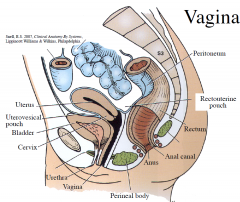
- Fibromuscular structure, 8 cm long x 4 cm wide. Passes forward and down
- Pierced by the cervix à fornices (anterior, lateral, posterior) - Posterior fornix is deeper and is related to rectouterine pouch (of Douglas). - Relationships: anterior = bladder; posterior = rectum and perineal body; lateral = ureter (lateral fornix), levator ani and bulb of vestibule - Fistulas may develop between vagina & bladder, urethra or rectum |
|
|
Shape of the Vagina
|
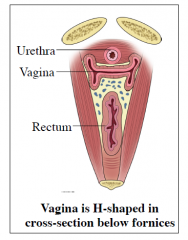
|
|
|
Fornices
|
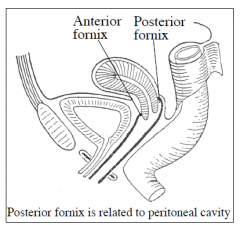
|
|
|
External Genitala
|

|
|
|
Lower Vagina
|
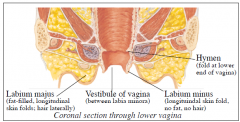
|
|
|
Hymen
|
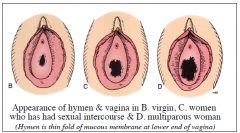
its at the boundary between the embryological outer third of vagina coming from perineium and the inner 2/3
|
|
|
Innervation in Female
|
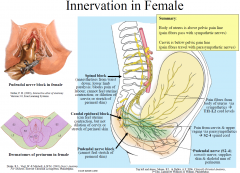
|
|
|
Greater and lesser Vestibular Glands
|
The greater vestibular (Bartholin's) glands open at the introitus, while the lesser vestibular (Skene's)
glands open near the urethral orifice |
|
|
Ant. Post. Commissure
|
• The anterior commissure is formed by the union of labia major anteriorly
• The posterior commissure is formed by the union of labia major posteriorly and marks the position of the perineal body on the skin (surface anatomy) |
|
|
Pelvic Pain line and Female Genitalia
|
• The body of the uterus is above the pelvic pain line, while the cervix is below the pelvic pain line
|
|
|
Examination of the cervix
|

|
|
|
Bimanual Palpation
|
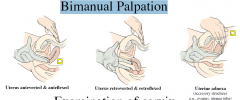
|

